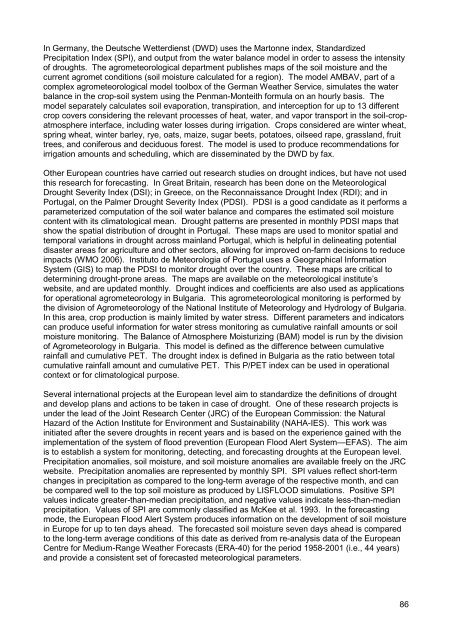Agricultural Drought Indices - US Department of Agriculture
Agricultural Drought Indices - US Department of Agriculture
Agricultural Drought Indices - US Department of Agriculture
You also want an ePaper? Increase the reach of your titles
YUMPU automatically turns print PDFs into web optimized ePapers that Google loves.
In Germany, the Deutsche Wetterdienst (DWD) uses the Martonne index, Standardized<br />
Precipitation Index (SPI), and output from the water balance model in order to assess the intensity<br />
<strong>of</strong> droughts. The agrometeorological department publishes maps <strong>of</strong> the soil moisture and the<br />
current agromet conditions (soil moisture calculated for a region). The model AMBAV, part <strong>of</strong> a<br />
complex agrometeorological model toolbox <strong>of</strong> the German Weather Service, simulates the water<br />
balance in the crop-soil system using the Penman-Monteith formula on an hourly basis. The<br />
model separately calculates soil evaporation, transpiration, and interception for up to 13 different<br />
crop covers considering the relevant processes <strong>of</strong> heat, water, and vapor transport in the soil-cropatmosphere<br />
interface, including water losses during irrigation. Crops considered are winter wheat,<br />
spring wheat, winter barley, rye, oats, maize, sugar beets, potatoes, oilseed rape, grassland, fruit<br />
trees, and coniferous and deciduous forest. The model is used to produce recommendations for<br />
irrigation amounts and scheduling, which are disseminated by the DWD by fax.<br />
Other European countries have carried out research studies on drought indices, but have not used<br />
this research for forecasting. In Great Britain, research has been done on the Meteorological<br />
<strong>Drought</strong> Severity Index (DSI); in Greece, on the Reconnaissance <strong>Drought</strong> Index (RDI); and in<br />
Portugal, on the Palmer <strong>Drought</strong> Severity Index (PDSI). PDSI is a good candidate as it performs a<br />
parameterized computation <strong>of</strong> the soil water balance and compares the estimated soil moisture<br />
content with its climatological mean. <strong>Drought</strong> patterns are presented in monthly PDSI maps that<br />
show the spatial distribution <strong>of</strong> drought in Portugal. These maps are used to monitor spatial and<br />
temporal variations in drought across mainland Portugal, which is helpful in delineating potential<br />
disaster areas for agriculture and other sectors, allowing for improved on-farm decisions to reduce<br />
impacts (WMO 2006). Instituto de Meteorologia <strong>of</strong> Portugal uses a Geographical Information<br />
System (GIS) to map the PDSI to monitor drought over the country. These maps are critical to<br />
determining drought-prone areas. The maps are available on the meteorological institute’s<br />
website, and are updated monthly. <strong>Drought</strong> indices and coefficients are also used as applications<br />
for operational agrometeorology in Bulgaria. This agrometeorological monitoring is performed by<br />
the division <strong>of</strong> Agrometeorology <strong>of</strong> the National Institute <strong>of</strong> Meteorology and Hydrology <strong>of</strong> Bulgaria.<br />
In this area, crop production is mainly limited by water stress. Different parameters and indicators<br />
can produce useful information for water stress monitoring as cumulative rainfall amounts or soil<br />
moisture monitoring. The Balance <strong>of</strong> Atmosphere Moisturizing (BAM) model is run by the division<br />
<strong>of</strong> Agrometeorology in Bulgaria. This model is defined as the difference between cumulative<br />
rainfall and cumulative PET. The drought index is defined in Bulgaria as the ratio between total<br />
cumulative rainfall amount and cumulative PET. This P/PET index can be used in operational<br />
context or for climatological purpose.<br />
Several international projects at the European level aim to standardize the definitions <strong>of</strong> drought<br />
and develop plans and actions to be taken in case <strong>of</strong> drought. One <strong>of</strong> these research projects is<br />
under the lead <strong>of</strong> the Joint Research Center (JRC) <strong>of</strong> the European Commission: the Natural<br />
Hazard <strong>of</strong> the Action Institute for Environment and Sustainability (NAHA-IES). This work was<br />
initiated after the severe droughts in recent years and is based on the experience gained with the<br />
implementation <strong>of</strong> the system <strong>of</strong> flood prevention (European Flood Alert System—EFAS). The aim<br />
is to establish a system for monitoring, detecting, and forecasting droughts at the European level.<br />
Precipitation anomalies, soil moisture, and soil moisture anomalies are available freely on the JRC<br />
website. Precipitation anomalies are represented by monthly SPI. SPI values reflect short-term<br />
changes in precipitation as compared to the long-term average <strong>of</strong> the respective month, and can<br />
be compared well to the top soil moisture as produced by LISFLOOD simulations. Positive SPI<br />
values indicate greater-than-median precipitation, and negative values indicate less-than-median<br />
precipitation. Values <strong>of</strong> SPI are commonly classified as McKee et al. 1993. In the forecasting<br />
mode, the European Flood Alert System produces information on the development <strong>of</strong> soil moisture<br />
in Europe for up to ten days ahead. The forecasted soil moisture seven days ahead is compared<br />
to the long-term average conditions <strong>of</strong> this date as derived from re-analysis data <strong>of</strong> the European<br />
Centre for Medium-Range Weather Forecasts (ERA-40) for the period 1958-2001 (i.e., 44 years)<br />
and provide a consistent set <strong>of</strong> forecasted meteorological parameters.<br />
86

















